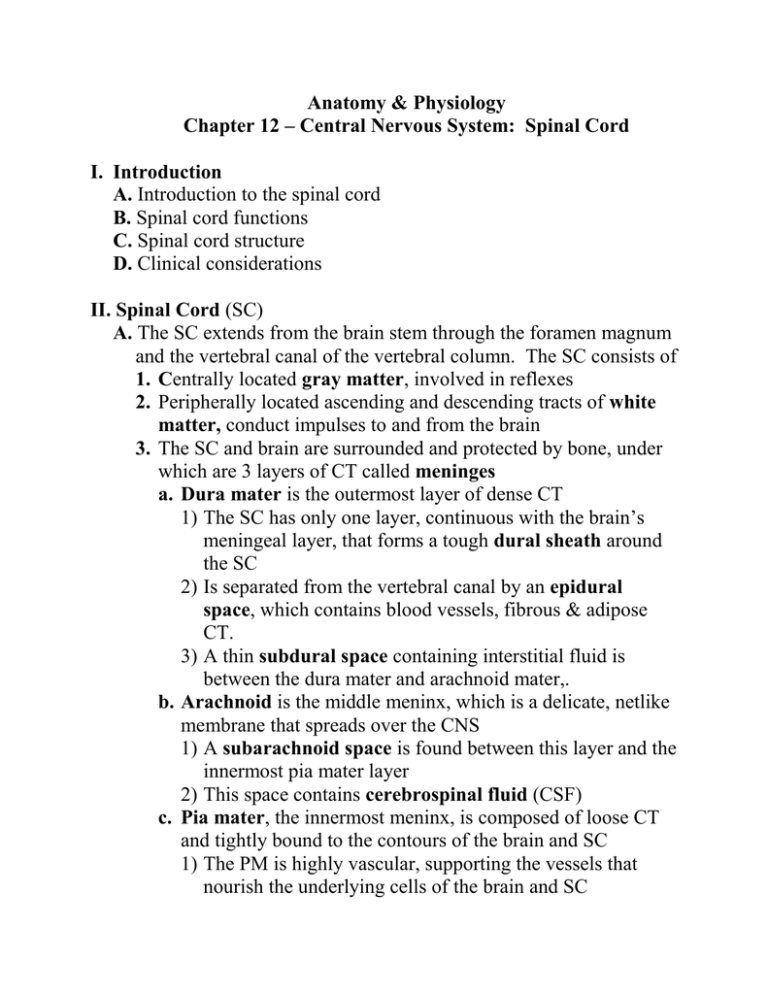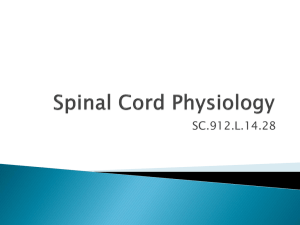CNS - Spinal Cord
advertisement

Anatomy & Physiology Chapter 12 – Central Nervous System: Spinal Cord I. Introduction A. Introduction to the spinal cord B. Spinal cord functions C. Spinal cord structure D. Clinical considerations II. Spinal Cord (SC) A. The SC extends from the brain stem through the foramen magnum and the vertebral canal of the vertebral column. The SC consists of 1. Centrally located gray matter, involved in reflexes 2. Peripherally located ascending and descending tracts of white matter, conduct impulses to and from the brain 3. The SC and brain are surrounded and protected by bone, under which are 3 layers of CT called meninges a. Dura mater is the outermost layer of dense CT 1) The SC has only one layer, continuous with the brain’s meningeal layer, that forms a tough dural sheath around the SC 2) Is separated from the vertebral canal by an epidural space, which contains blood vessels, fibrous & adipose CT. 3) A thin subdural space containing interstitial fluid is between the dura mater and arachnoid mater,. b. Arachnoid is the middle meninx, which is a delicate, netlike membrane that spreads over the CNS 1) A subarachnoid space is found between this layer and the innermost pia mater layer 2) This space contains cerebrospinal fluid (CSF) c. Pia mater, the innermost meninx, is composed of loose CT and tightly bound to the contours of the brain and SC 1) The PM is highly vascular, supporting the vessels that nourish the underlying cells of the brain and SC 2 d. Meningitis is an inflammation of the meninges, usually caused by bacteria or viruses 1) The arachnoid and pia mater are most frequently affected 2) Meningitis is accompanied by fever and headache 3) Untreated meningitis can result in paralysis, coma, death B. Spinal Cord Functions 1. Impulse conduction to and from the brain via peripheral white matter tracts a. Ascending tracts conduct impulses from peripheral sensory receptors to the brain b. Descending tracts conduct impulses from the brain to motor neurons that affect muscles and glands 2. Reflex integration – centrally located gray matter is involved in spinal reflexes to effectors (muscles and glands) C. Spinal Cord Structures 1. The SC extends from the foramen magnum to the first lumbar vertebrae (L1) and has 31 paired spinal nerves extending through the intervertebral foramina laterally from C1 to S5 2. Spinal Nerves - 31 paired nerves extend laterally from the spinal cord out to effectors, and include: a. 8 pr. Cervical (C1-C8) b. 12 pr. Thoracic (T1-T12) c. 5 pr. Lumbar (L1-L5) d. 5 pr. Sacral (S1-S5) e. 1 pr. Coccygeal (Co) 3. Cervical, lumbar, and sacral spinal nerves form plexuses (branching nerve networks) to body limbs. 4. Nerve roots, called the cauda equina, radiate inferiorly from the distal end of the SC through the vertebral canal 5. Two grooves, an anterior median fissure and a posterior median sulcus, extend the length of the SC and divide it into right and left portions 3 6. The SC is composed of centrally located gray matter surrounded by white matter a. The gray matter core resembles an “H” and is composed of nerve cell bodies, neuroglia, and unmyelinated association neurons (interneurons) 1) Paired posterior horns extend dorsally to the dorsal root ganglion, which contains sensory neuron cell bodies 2) Paired anterior horns extend ventrally, and contain somatic motor neuron cell bodies whose axons extend out to muscles 3) Paired lateral horns between posterior and anterior horns extend laterally, and contain autonomic motor neuron cell bodies 4) In the middle is the central canal, which is continuous with the brain ventricles and contains CSF b. The white matter consists of bundles, or tracts, of ascending and descending myelinated nerve fibers 1) Ascending tracts conduct sensory impulses to the brain. An important ascending tract is: a) Spinothalmic - conducts impulses for touch, pressure, pain, and temperature to the thalamus, where they are relayed to somatosensory cortex of the brain 2) Descending tracts conduct motor impulses from the brain. An important descending tract is: a) Corticospinal (pyramidal) - conduct impulses from the cerebral motor cortex in the brain to spinal nerves for voluntary skeletal muscle movements 7. Cerebrospinal fluid (CSF) – produced by choroid plexuses (ependymal cells and capillaries) in brain ventricles, circulates in and around the spinal cord and brain. Features include: a. Supports and protects the brain and spinal cord b. Maintains a stable ion and nutrient concentration c. Composition similar to blood plasma, but has less proteins 4 d. Removes waste products to the blood e. Pathway of CSF circulation: choroid plexus → lateral ventricles → interventricular foramen → third ventricle → cerebral aqueduct → fourth ventricle → central canal of SC OR to subarachnoid space of brain → dural sinuses → blood stream III. Clinical Considerations A. Neurological assessments (spinal cord) & drugs 1. A lumbar puncture (spinal tap) is performed by inserting a needle between L3 & L4 and withdrawing CSF from the subarachnoid space for analysis 2. Epidural anesthesia (saddle block) is sometimes injected into the epidural space of the lumbar region of the spine to ease the trauma of child birth B. Developmental Problems of the Spinal Cord 1. Spina bifida - some vertebrae don’t fuse around the SC; may cause neurological problems 2. Spina bifida cystica - a sac-like protrusion of skin and underlying meninges that may contain portions of the SC and roots; most common in lower thoracic, lumbar, and sacrum; may result in hydrocephalus and paralysis if untreated. C. Spinal Cord Damage 1. Paraplegia – paralysis of the lower limbs due to damage to the spinal cord between T1 & L2. 2. Quadraplegia – paralysis of all four limbs due to damage to the cervical region of the spinal cord





